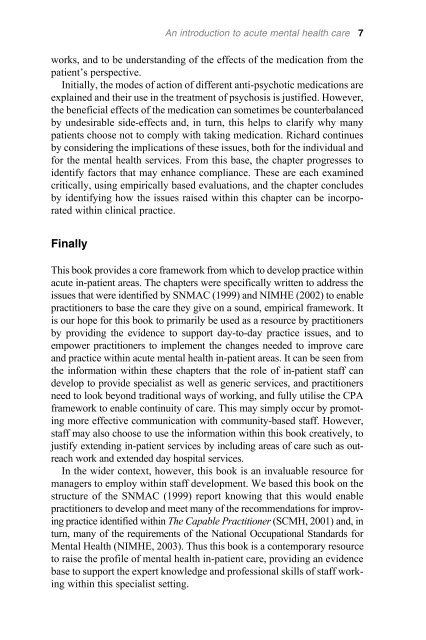Mental Health Nursing
Mental Health Nursing
Mental Health Nursing
Create successful ePaper yourself
Turn your PDF publications into a flip-book with our unique Google optimized e-Paper software.
works, and to be understanding of the effects of the medication from the<br />
patient’s perspective.<br />
Initially, the modes of action of different anti-psychotic medications are<br />
explained and their use in the treatment of psychosis is justified. However,<br />
the beneficial effects of the medication can sometimes be counterbalanced<br />
by undesirable side-effects and, in turn, this helps to clarify why many<br />
patients choose not to comply with taking medication. Richard continues<br />
by considering the implications of these issues, both for the individual and<br />
for the mental health services. From this base, the chapter progresses to<br />
identify factors that may enhance compliance. These are each examined<br />
critically, using empirically based evaluations, and the chapter concludes<br />
by identifying how the issues raised within this chapter can be incorporated<br />
within clinical practice.<br />
Finally<br />
An introduction to acute mental health care 7<br />
This book provides a core framework from which to develop practice within<br />
acute in-patient areas. The chapters were specifically written to address the<br />
issues that were identified by SNMAC (1999) and NIMHE (2002) to enable<br />
practitioners to base the care they give on a sound, empirical framework. It<br />
is our hope for this book to primarily be used as a resource by practitioners<br />
by providing the evidence to support day-to-day practice issues, and to<br />
empower practitioners to implement the changes needed to improve care<br />
and practice within acute mental health in-patient areas. It can be seen from<br />
the information within these chapters that the role of in-patient staff can<br />
develop to provide specialist as well as generic services, and practitioners<br />
need to look beyond traditional ways of working, and fully utilise the CPA<br />
framework to enable continuity of care. This may simply occur by promoting<br />
more effective communication with community-based staff. However,<br />
staff may also choose to use the information within this book creatively, to<br />
justify extending in-patient services by including areas of care such as outreach<br />
work and extended day hospital services.<br />
In the wider context, however, this book is an invaluable resource for<br />
managers to employ within staff development. We based this book on the<br />
structure of the SNMAC (1999) report knowing that this would enable<br />
practitioners to develop and meet many of the recommendations for improving<br />
practice identified within The Capable Practitioner (SCMH, 2001) and, in<br />
turn, many of the requirements of the National Occupational Standards for<br />
<strong>Mental</strong> <strong>Health</strong> (NIMHE, 2003). Thus this book is a contemporary resource<br />
to raise the profile of mental health in-patient care, providing an evidence<br />
base to support the expert knowledge and professional skills of staff working<br />
within this specialist setting.
















